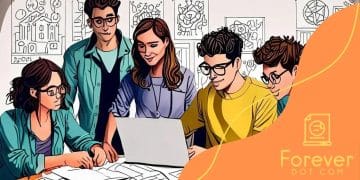Shifting focus towards career-oriented education in universities

Shifting focus towards career-oriented education in universities involves adapting curricula to emphasize real-world skills, integration of technology, and collaboration with industries, ensuring students are effectively prepared for the job market.
Shifting focus towards career-oriented education in universities might just be the key to bridging the gap between education and employment. Have you noticed how quickly job markets evolve? It’s crucial for universities to keep pace and prepare students effectively.
The importance of career-oriented education
Understanding the importance of career-oriented education is vital for students today. With job markets changing rapidly, it’s essential for educational institutions to prepare students effectively.
Bridging the Skills Gap
Many students graduate with degrees but lack the specific skills employers seek. Career-oriented education helps bridge this gap by aligning coursework with real-world job requirements. This approach ensures students are job-ready upon graduation.
Key Benefits
- Employability: Students gain skills that increase their chances of finding employment.
- Hands-on Experience: Programs often include internships or practical training.
- Networking Opportunities: Students can connect with industry professionals.
Additionally, when universities focus on career-oriented education, they enhance their reputation. Educational institutions that emphasize relevant skills attract more students. Students, in turn, become more successful, which creates a positive cycle.
As industries evolve, so do the demands for skills. Universities incorporating new technologies and trends in their curriculum show adaptability. This ensures that graduates are prepared for roles not yet fully defined, fostering a culture of continuous learning.
Career-oriented education doesn’t just benefit students; it also helps employers. Companies can find candidates who already have practical knowledge and are ready to contribute. This reduces training time and costs associated with onboarding new hires.
How universities can adapt curricula
To stay relevant, universities must understand how they can adapt curricula to meet the evolving needs of students and employers. This requires a commitment to innovation and flexibility.
Integrating Technology
One effective way to adapt is by integrating technology into learning experiences. Many programs now use online tools and platforms for collaboration. This enables students to learn essential skills in a familiar environment, making education more engaging.
Collaboration with Industry
Universities should also collaborate more closely with industry leaders. By seeking input from businesses, schools can align their programs with real-world job requirements. This helps ensure that students graduate with the competencies employers are looking for. Engaging in partnerships can lead to:
- Guest lectures: Industry experts can share insights and trends.
- Internship opportunities: Students gain real work experience.
- Curriculum guidance: Companies provide advice on critical skills and knowledge.
Another approach is to focus on project-based learning. This method encourages students to work on actual business problems. By solving real challenges, they gain practical experience and develop vital skills. Working together on projects also helps enhance teamwork and communication abilities.
Furthermore, universities can introduce interdisciplinary programs. Blending fields like technology, business, and arts can create a more holistic educational experience. Students equipped with diverse skills are better prepared for the complexities of modern workplaces.
Real-world skills students need today

Students today face a rapidly changing job market, making it crucial to acquire real-world skills that employers value. These skills help bridge the gap between education and the workplace, ensuring students are well-prepared for their careers.
Essential Skills
Some core skills that are in high demand include:
- Communication: Ability to express ideas clearly and effectively.
- Problem-solving: Critical thinking skills to address challenges creatively.
- Teamwork: Working collaboratively with others to achieve common goals.
These skills enable students to navigate complex workplace dynamics. Employers frequently seek candidates who can not only perform tasks but also enhance team performance through strong communication and collaboration.
Adaptability and Lifelong Learning
In addition to hard skills, students must develop soft skills like adaptability. The ability to change course, learn new technologies, or adjust to new environments is essential in the modern workforce. Furthermore, fostering a mindset of lifelong learning empowers students to keep their skills sharp throughout their careers.
Employers appreciate when candidates demonstrate a willingness to grow and innovate. Workshops, internships, and mentorship programs offer students valuable opportunities to cultivate these skills in real settings.
Lastly, digital literacy is increasingly important. Understanding technology and how to use digital tools effectively can give students an edge in any field. Being proficient with software applications and online communication channels is essential for success.
Success stories of universities making changes
Many universities are leading the way in adapting their programs for the better. Examining success stories of universities making changes provides valuable insight into effective educational practices. These institutions are designers of change, aiming to better serve students and the workforce.
Case Study: University of Arizona
The University of Arizona has implemented innovative programs that focus on hands-on learning. By partnering with local businesses, they have created internship opportunities for students. This approach helps students gain real-world experience while still in school. Not only does this prepare graduates for the job market, but it also builds strong connections between the university and the community.
Case Study: Purdue University
Purdue University has also made significant strides in aligning its curriculum with job market needs. Their initiative, called “The Purdue Polytechnic Institute,” focuses on experiential learning. Students work on projects that solve real-world problems. This program emphasizes skills like teamwork and problem-solving, which are highly valued by employers.
Another successful university is Georgia State University, which adopted data-driven approaches to support student retention. By analyzing student performance data, the university has been able to identify at-risk students. They then provide targeted support, which has led to increased graduation rates. This proactive approach ensures that more students complete their degrees successfully.
These examples show that universities can indeed make impactful changes by being responsive to the needs of students and employers. As more institutions adopt similar practices, the landscape of higher education continues to evolve.
Future trends in career-oriented education
The landscape of education is constantly evolving, and understanding future trends in career-oriented education is essential for universities and students alike. As technology advances and industries change, the way we approach education must also adapt.
Emphasis on Soft Skills
One of the key trends is the growing emphasis on soft skills. Employers are looking for candidates who not only have technical expertise but also strong interpersonal abilities. Skills like communication, problem-solving, and collaboration will be increasingly prioritized in educational programs.
Integration of Technology
Another important trend is the integration of technology into the learning process. Online tools and platforms are becoming essential resources for educators and students. Many universities are adopting blended learning models that combine traditional classroom settings with online courses.
- Virtual Reality (VR): VR technology is being used for simulations that offer hands-on learning experiences.
- Artificial Intelligence (AI): AI can personalize learning, adapting to the needs of each student.
- Data Analytics: Leveraging data helps institutions track student performance and improve outcomes.
Moreover, the focus on real-world applications in the curriculum is increasing. Schools are collaborating with businesses to create programs that reflect actual job requirements. This connection not only helps boost student engagement but also prepares graduates for the workforce.
Finally, lifelong learning will continue to be a significant trend. With the rapid pace of change in many industries, employees will need to continually update their skills. Educational institutions are starting to recognize this need and are offering more flexible, non-degree programs aimed at working adults.
FAQ – Frequently Asked Questions about Career-Oriented Education
What is career-oriented education?
Career-oriented education focuses on equipping students with the skills and knowledge needed for specific jobs, ensuring they are job-ready after graduation.
Why are soft skills important in today’s job market?
Soft skills, such as communication and teamwork, are essential because employers value candidates who can work well with others and adapt to different situations.
How does technology integration enhance learning?
Technology integration allows students to use digital tools and resources, making learning more interactive and aligned with modern workplace demands.
What is the benefit of collaborative learning with industries?
Collaborative learning with industries helps students gain real-world experience, making them more attractive to employers and better prepared for their careers.






